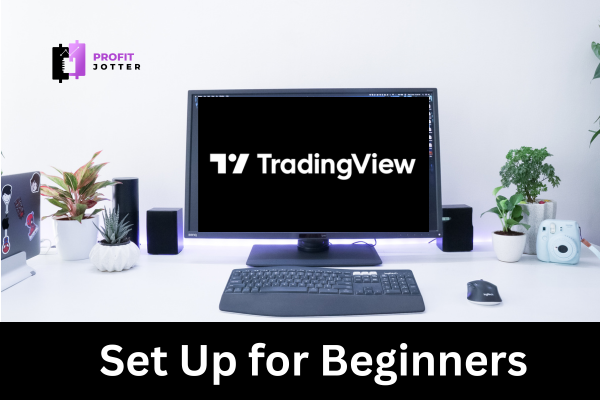TradingView is a powerful charting platform that has picked up impressive speed among traders.
It offers a wide array of tools for financial market analysis.
Whether you are a beginner in the trading world or looking to hone your skills, this best TradingView setup improves your experience.
This guide will walk you through the best TradingView setup for beginners, incorporating essential features, tools, and strategies to optimize your trading journey.
Why Choose TradingView?
Today, TradingView has over 30 million users worldwide.
Among available trading platforms, it is one of the most popular solutions.
Its ease of use and rich support within the vast community are enough to justify the causes of its popularity.
According to the research conducted by Statista, nearly 65% of traders use online charting tools such as TradingView.
This is because they are available and easier to work with.
Below, I explained how to get started with TradingView.
Getting Started with TradingView
1. Creating Your Account
To get started with TradingView, follow these steps:
– Sign up: From the TradingView website, you can create an account for free. You can upgrade anytime you want to access further features.
– Choose Your Plan: It offers some plans that include Free, Pro, Pro+, and Premium. The free version works for most beginners, but once you find you need more indicators or other additional features, upgrading will be considered.
2. Getting Used to the Interface
Well, first things first: get used to the TradingView interface. The platform is divided into three main toolbars:
– Toolbar 1: Modify time scales, settings, and chart appearance.
– Toolbar 2: Access drawing tools like trend lines and Fibonacci retracements.
– Toolbar 3: View market overviews, news feeds, and social features.
Knowing what each part of the platform does will help the trader use it much easier.
Recommended Features For Beginners
Chart Types
Knowing the right chart type one is dealing with is crucial in carrying out efficient analysis:
– Candlestick Charts: Probably the most used because they can show fluctuations in price within a particular time frame.
– Line Charts: Useful for showing the trend of something over time.
– Heikin Ashi Charts: These smooth out price action and thereby help in recognizing trends more clearly.
Indicators
Indicators are indispensable when it comes to performing technical analysis.
Here, the novice trader will want to consider some simple, easy-to-use indicators:
– Moving Averages (MA): Used to spot the trend direction in an averaging manner for price data in a particular period.
– Relative Strength Index (RSI): The speed and change of price movement are measured, which is useful for any overbought or oversold conditions.
– Volume Indicators: These are indicative of the amount of the underlying asset being traded. This shows potential price movements in the market.
Customization Options
Customizing your charts can enhance your trading experience:
– Chart Appearance: In the settings menu, change colors and styles to make charts visually appealing.
– Templates: Save your favorite settings as templates for easy access in later sessions.
Operating Tools and Features
Drawing Tools
Drawing tools allow you to show key levels right on your charts:
– Trend Lines: Help you to better visualize the direction of the market.
– Fibonacci Retracement: Useful for finding potential reversal levels based on historical price movements.
– Annotations: Attach notes or comments directly to your charts so that you remember the most vital points.
Alerts
Setting alerts is crucial for staying updated on market movements without constant monitoring:
– Create alerts based on specific price levels or indicator signals. This feature ensures you never miss critical trading opportunities.
Paper Trading
For beginners, practicing with paper trading is invaluable:
– Use TradingView’s paper trading feature to simulate real trades without any financial risk. This allows you to test strategies and gain confidence before committing real capital
One of the strong points for TradingView is its community:
Community Interaction
One of TradingView’s strengths is its vibrant community:
– Engage in forum discussions or follow experienced traders to learn from their insights.
– Share your thoughts and analyses with others; this may provide worthy feedback that helps you improve in seeing market action.
Building Your Workflow
Having a structured workflow will streamline the whole trading process:
1. Create Your Watchlist: Track the assets in which you’re interested by adding them to a watchlist. This will help orient you toward respective markets rather than drowning in information.
2. Establish a Routine: Devote time daily to studying charts, reviewing performance, and adjusting strategy to meet the market conditions.
3. Keep a Record of Your Trades: Keep a trading journal in which you note the date of your trades, the strategy involved, and the outcomes. Keeping such a journal helps you to know and understand your pattern of trading and the areas where you need to work.
Conclusion
Setting up TradingView as a novice supercharges your trading experience.
By leveraging powerful in-depth features, ranging from charts to key indicators, drawing tools, alerts, and community engagement, you will be well-versed and develop a deeper insight into the dynamics of financial markets.
Remember, practice is key, so take full advantage of paper trading to build confidence before diving into live markets.
Once you get comfortable with the platform, don’t stop tweaking the setup to meet and match your ever-evolving trading style and preferences.
Happy trading!



